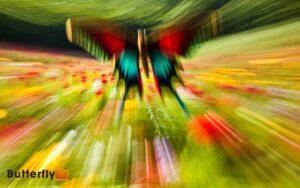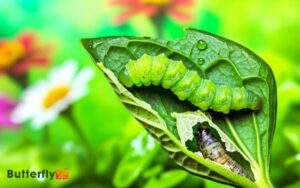How Do Butterfly Eggs Look Like and What Are Their Defining Features?
Butterfly eggs exhibit considerable diversity in size, shape, and color, ranging from 0.5 mm to 3 mm in diameter. Spherical, cylindrical, and conical shapes are observed, with colors spanning creamy whites, vibrant greens, and metallic hues.
These variations guarantee camouflage and thermal regulation. Eggs are often affixed to the underside of leaves or stems using specialized adhesives, enhancing security against predation and desiccation.
Species-specific adaptations, such as the white eggs of the Monarch butterfly blending with milkweed leaves, reflect meticulous ecological strategies. Understanding these intricate details offers deeper insights into butterfly reproductive success and survival strategies.
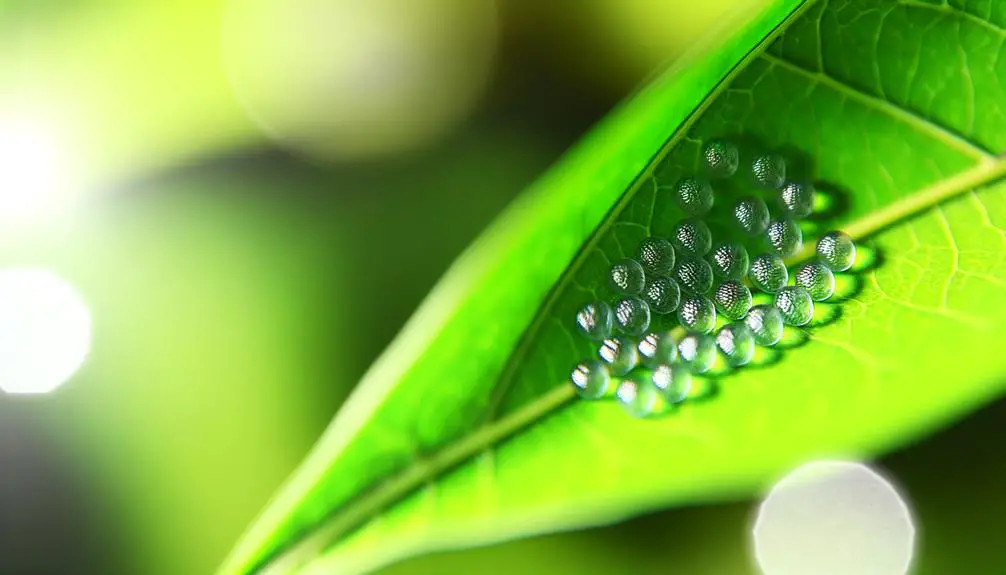
Key Takeaways
- Butterfly eggs vary in size from 0.5 mm to 3 mm in diameter.
- Egg colors range from pale whites and yellows to vibrant greens and metallic shades.
- Shapes include spherical, cylindrical, conical, and flattened forms.
- Surface textures feature patterns like ridges, pits, and hexagonal grids.
Size Variations
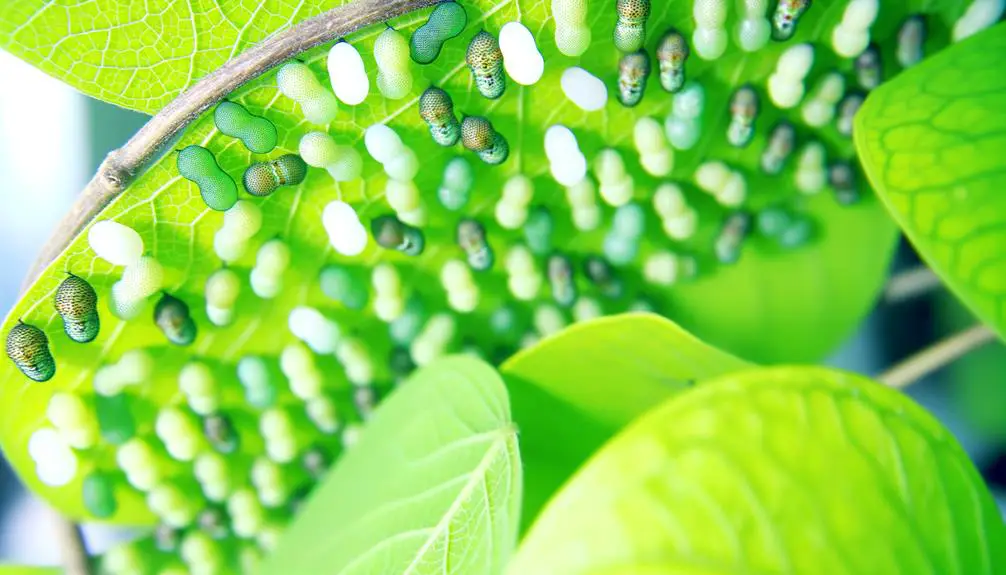
How do the size variations among butterfly eggs correlate with species-specific reproductive strategies and environmental adaptations?
Butterfly eggs exhibit a remarkable range of sizes, reflecting evolutionary adaptations to their ecological niches.
Larger eggs generally contain more yolk, providing enhanced embryonic nutrition, advantageous in resource-scarce environments or for species with fewer offspring.
Conversely, smaller eggs are often associated with species employing high fecundity strategies, producing numerous offspring to increase survival probabilities despite higher predation risks.
Additionally, egg size can influence desiccation resistance, with larger eggs exhibiting lower surface-to-volume ratios, thereby reducing water loss.
These size variations are not arbitrary but rather represent finely tuned responses to environmental pressures, reproductive success, and survival strategies within diverse ecological contexts.
Color Differences
In addition to size variations, butterfly eggs also exhibit a wide array of color differences, which serve as adaptive mechanisms for camouflage, thermoregulation, and species-specific signaling.
These hues range from pale whites and yellows to vibrant greens and even metallic shades. The coloration often correlates with the host plant, enhancing concealment from predators.
For instance, eggs of the Monarch butterfly (Danaus plexippus) are typically white, blending seamlessly with milkweed leaves. Conversely, the Common Blue (Polyommatus icarus) lays eggs that are green, matching the foliage. This natural camouflage helps protect the eggs from predators, increasing the chances of survival. Observers often find butterfly eggs on milkweed by carefully inspecting the undersides of leaves, where they are strategically placed for protection. This adaptation ensures that newly hatched larvae have immediate access to their primary food source.
Furthermore, darker pigments can absorb more heat, facilitating embryonic development in cooler climates.
As a result, the diverse color palette of butterfly eggs is an indication of evolutionary strategies tailored to environmental niches and survival imperatives.
Shape Diversity
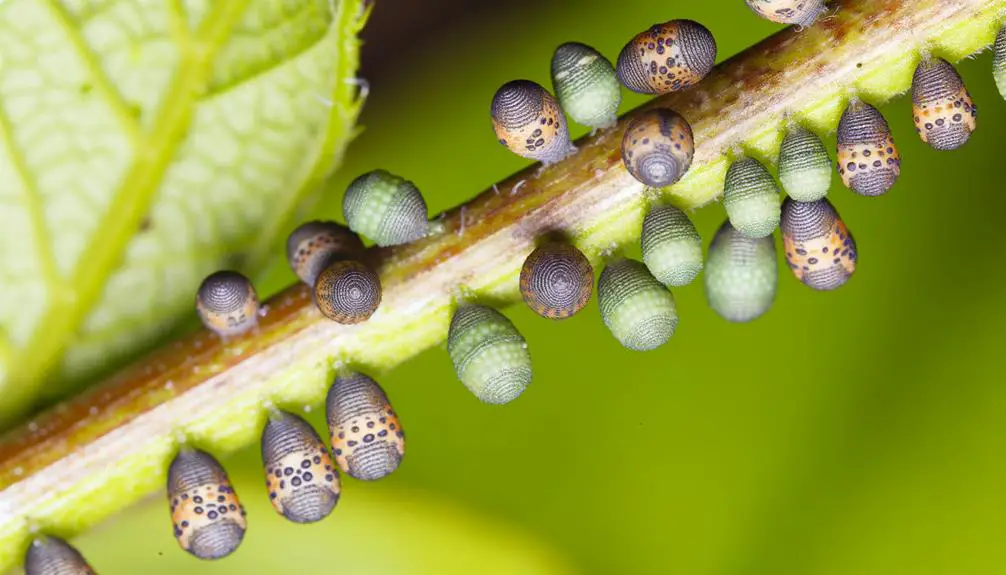
The morphological diversity of butterfly eggs encompasses a myriad of shapes, including spherical, cylindrical, conical, and flattened forms, each adapted to optimize survival and development within specific ecological contexts.
Spherical eggs, such as those of the Monarch butterfly (Danaus plexippus), provide structural integrity and maximize surface area for gas exchange.
Cylindrical forms, seen in the Painted Lady (Vanessa cardui), facilitate attachment to narrow substrates.
Conical eggs, like those of the Swallowtail (Papilionidae), reduce predation risk by camouflaging with plant structures.
Flattened eggs, characteristic of the Nymphalidae family, guarantee stability on leaf surfaces.
These varied morphologies illustrate evolutionary adaptations to enhance embryonic development, minimize predation, and guarantee successful hatching in diverse environmental conditions.
Egg Laying Process
The egg-laying process in butterflies encompasses the critical selection of oviposition sites and the precise mechanism of egg deposition.
Female butterflies exhibit highly selective behavior, often utilizing chemoreceptors to evaluate host plants for ideal larval development.
The ovipositor, a specialized organ, facilitates the accurate placement of eggs, ensuring adherence to the chosen substrate.
Selecting Egg Sites
Female butterflies exhibit a highly selective process when choosing oviposition sites, meticulously evaluating factors such as plant species, microclimate, and potential predation risks to guarantee ideal conditions for their offspring.
Host plant specificity is paramount, as larvae are often monophagous, relying on a single plant species for nourishment.
Microclimatic conditions, including temperature, humidity, and light exposure, are also critical, as they influence egg viability and larval development.
In addition, females assess the presence of natural enemies, such as parasitoids and predators, to minimize mortality risks.
Behavioral adaptations, such as antennal drumming and tarsal chemoreception, enable butterflies to discern optimal substrates.
This rigorous selection process underscores the intricate evolutionary strategies employed to enhance reproductive success in butterflies.
Egg Deposition Mechanism
Through a highly coordinated sequence of behaviors, the oviposition process in butterflies involves the precise placement of eggs on selected substrates to optimize offspring survival and development. This process is critical for guaranteeing that larvae have immediate access to suitable food sources upon hatching.
Female butterflies utilize specialized sensory organs called chemoreceptors to identify and evaluate potential oviposition sites.
Key steps in the egg deposition mechanism include:
- Substrate Selection: Females select host plants based on chemical cues to guarantee nutritional suitability.
- Attachment: Eggs are carefully affixed to the substrate using a specialized adhesive.
This meticulous process exemplifies the evolutionary adaptations that enhance reproductive success in butterflies.
Protective Mechanisms
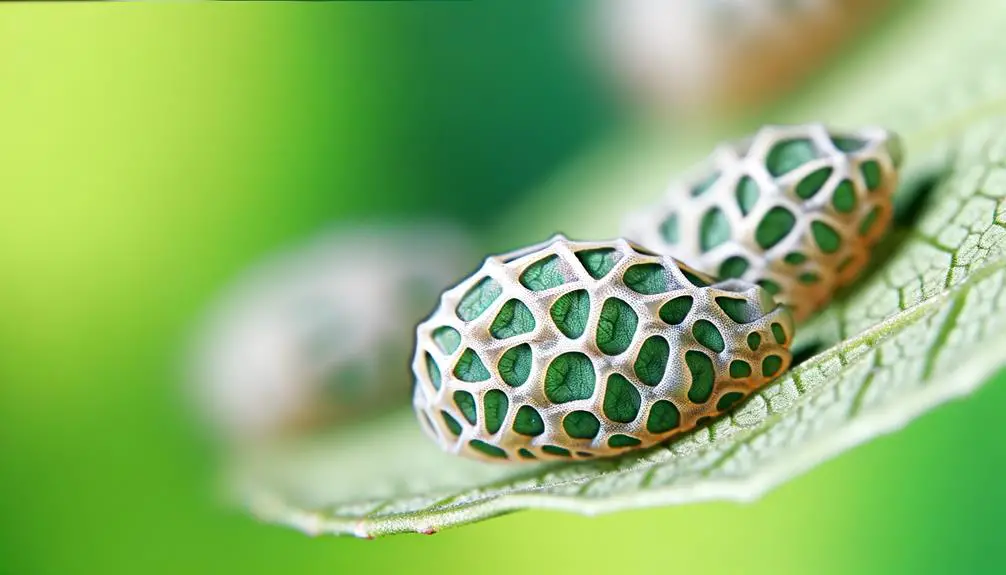
Adaptations in butterfly eggs include a variety of protective mechanisms such as cryptic coloration, chemical defenses, and specialized structures to deter predators and guarantee survival.
Cryptic coloration enables the eggs to blend with their surroundings, rendering them less detectable to predators.
Chemical defenses often involve the secretion of deterrent substances that are either toxic or unpalatable to potential threats.
Additionally, some species possess protective structures like spines or hard outer shells, which provide a physical barrier against predation and environmental hazards.
These mechanisms are essential for the early stages of development, ensuring that a higher proportion of eggs reach the larval stage.
Understanding these adaptations illuminates the evolutionary strategies butterflies employ to maximize reproductive success.
Common Egg Locations
Butterfly eggs are mainly deposited on the leaves and stems of specific host plants, demonstrating a highly selective oviposition behavior.
This selection is influenced by the plant's chemical composition, which guarantees ideal larval nutrition and survival.
In addition, environmental factors such as temperature, humidity, and light exposure greatly impact the suitability of these locations for egg-laying.
Leaves and Stems
Many butterfly species strategically deposit their eggs on the underside of leaves and along the stems of host plants to optimize the survival and development of their larvae. This behavior minimizes predation and exposure to harsh environmental conditions.
Detailed observations indicate that the microhabitats selected for oviposition are characterized by:
- High humidity levels: Critical for preventing egg desiccation.
- Optimal temperature ranges: Ensuring proper embryonic development.
The intricate choice of leaves and stems involves evaluating factors such as plant texture, chemical composition, and microclimate.
The underside of leaves offers a microenvironment that shields eggs from direct sunlight and rainfall, while stems provide structural support and a steady supply of nutrients for emerging larvae.
Host Plant Selection
In the domain of host plant selection, butterflies exhibit a remarkable preference for specific plant species that provide ideal conditions for egg deposition and subsequent larval development. This selective behavior guarantees that emerging larvae have immediate access to suitable nourishment. The choice of host plant is often dictated by chemical cues and physical characteristics of the plant, which can vary among butterfly species.
| Butterfly Species | Common Host Plant |
|---|---|
| Monarch (Danaus plexippus) | Milkweed (Asclepias spp.) |
| Swallowtails (Papilio spp.) | Citrus (Citrus spp.) |
| Painted Lady (Vanessa cardui) | Thistle (Cirsium spp.) |
These host plants serve as critical resources, influencing the survival and fitness of the butterfly's next generation. The specificity of plant selection underscores the intricate relationship between butterfly species and their environment.
Environmental Factors Impact
The selection of host plants by butterflies is intricately connected to environmental factors that greatly influence common egg deposition locations. These factors include temperature, humidity, and plant availability, all playing essential roles in the survival of the eggs and subsequent larvae.
- Microclimate Conditions: Ideal temperature and humidity levels are vital for egg viability.
- Vegetation Density: The abundance and type of flora provide necessary shelter and food sources for larvae.
Butterflies exhibit selective behavior, often laying eggs on the underside of leaves or within dense foliage to protect them from environmental stressors and predators.
This meticulous choice guarantees the continuation of their lifecycle in favorable microhabitats.
Identification Tips
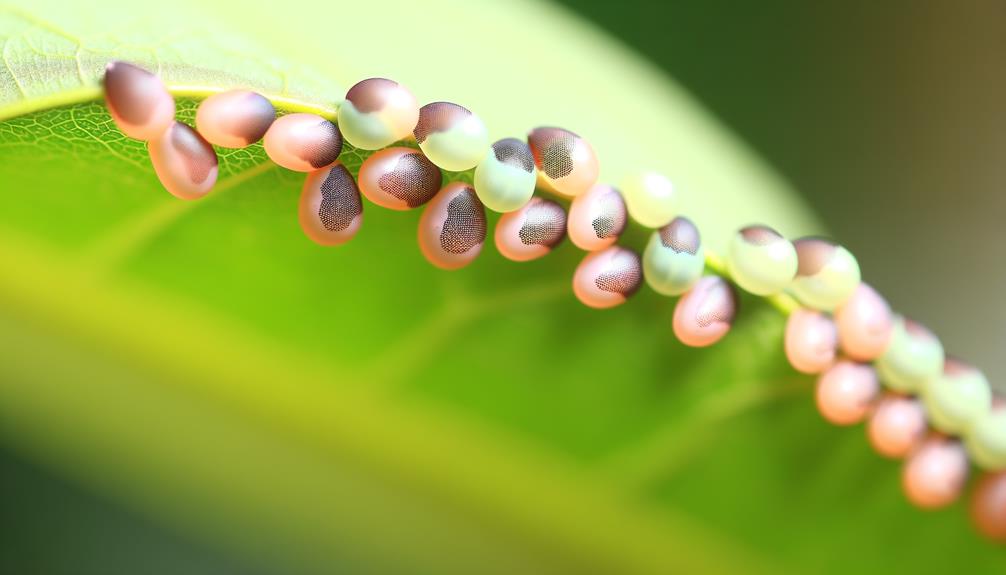
Accurate identification of butterfly eggs necessitates close examination of their size, shape, color, and surface texture, often requiring magnification tools for detailed analysis.
Butterfly eggs vary greatly across species, exhibiting dimensions from 0.5 mm to 3 mm in diameter. Morphological observations reveal diverse forms, including spherical, cylindrical, and conical shapes.
Chromatic variations span from creamy whites and greens to striking yellows and reds. Surface textures exhibit intricate patterns such as ridges, pits, and hexagonal grids, discernible through stereomicroscopy.
Employing a dichotomous key can facilitate accurate taxonomic classification. Additionally, documenting oviposition substrates, such as specific host plants, enhances identification accuracy.
These precise methodologies are critical for lepidopterists and entomologists engaged in ecological studies and conservation efforts.
Conclusion
Butterfly eggs, resembling delicate droplets of life, exhibit an array of sizes, colors, and shapes, reflecting their species-specific diversity.
The meticulous egg-laying process, often accompanied by protective mechanisms, guarantees the continuity of these ethereal creatures.
Typically found on host plants, the precise identification of butterfly eggs necessitates careful observation of their unique characteristics.
This intricate tapestry of variation and detail underscores the complexity and beauty inherent in the early stages of a butterfly's life cycle.


